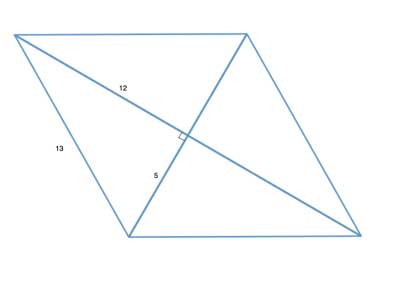How Do You Find The Diagonal Of A Parallelogram
The basic formula for calculating the surface area of a parallelogram is the length of 1 side times the height of the parallelogram to that side.
But what do we practise when nosotros do non have these measurements (side, height)? What if instead we are presented with the length of i side, and the length of both diagonals?
Let's come across how we can still compute the area of the parallelogram in that case, in the following trouble.

Problem
A parallelogram has a side of length 13 units, and its diagonal lengths are 24 units and 10 units. Find its expanse.
Strategy
There are two ways to start thinking about this problem, and both will lead us to the aforementioned signal and the solution.
Since we take both the diagonals, nosotros can start past thinking most the backdrop of diagonals in parallelograms - they bisect each other. So if we take diagonals of 24 and 10 units, they bisect each other into segments of 12 units and v units, respectively:

So now we accept a triangle with sides 5, 12 and 13 - a Pythagorean Triple, which means the triangle is a correct triangle, and we tin can easily compute its area as leg 10 leg /2, or 5x12/2=30.
But if m∠AOB=90°, then m∠AOD=90°, as ∠AOB and ∠AOD are a linear pair which add up to 180°. Triangles ΔAOB and ΔAOD are then coinciding (by Side-Bending-Side), every bit are triangles ΔAOB and ΔCOB (also Side-Angle-Side). Then we take four triangles of area xxx making up the expanse of the parallelogram, whose surface area is thus 4x30=120.
Another manner to remember nearly the trouble is to remember that if the parallelogram is a rhombus, and then its area is the product of the diagonals divided past two. That is because a rhomb is also a kite, and we've shown that the area of a kite is half the product of its diagonals.
So if we prove the parallelogram is a rhomb, nosotros can use that directly. We can go on to testify that this parallelogram is indeed a rhombus, using the fact that if a parallelogram's diagonals are perpendicular, information technology is a rhombus - and we've shown above that these diagonals are indeed perpendicular.
So the areas of the parallelogram is (diagonal 10 diagonal /2 ), or 24x10/2=120, as above.
Solution
(1) AC=24 //Given
(ii) BD=10 //Given
(3) AO=OC=12 //Diagonals of a parallelogram bifurcate each other
(4) BO=OD=v //Diagonals of a parallelogram bisect each other
(5) AB=13 //Given
(6) g∠AOB=90° //(3), (four), (v), Antipodal of the Pythagorean theorem (5,12,13 are a Pythagorean Triple)
(7) Air-conditioning⊥DB //(vi), definition of perpendicular lines
(8) ABCD is a rhombus //a parallelogram with perpendicular diagonals is a rhomb
(9) Surface areaABCD=|AC|·|DB|/2 //Area of a rhombus is the product of the diagonals, divided by two
(ten) AreaABCD =24·x/2=120 foursquare units //(ane),(2), (nine)
And so in this case, we have diagonals and a side of a parallelogram which happen to form a Pythagorean triple. This makes for an easy adding of the expanse of the parallelogram. Only what virtually other parallelograms, where the diagonals are not perpendicular?
It turns out nosotros can find out the area of the parallelogram for those cases, too. We'll just take to use a little more calculations known as Heron'due south formula for the surface area of a triangle which is not a right triangle.
Source: https://geometryhelp.net/area-parallelogram-given-diagonals-side/
Posted by: jonesaffeekly.blogspot.com

0 Response to "How Do You Find The Diagonal Of A Parallelogram"
Post a Comment